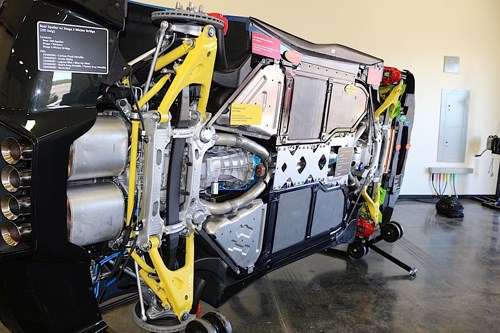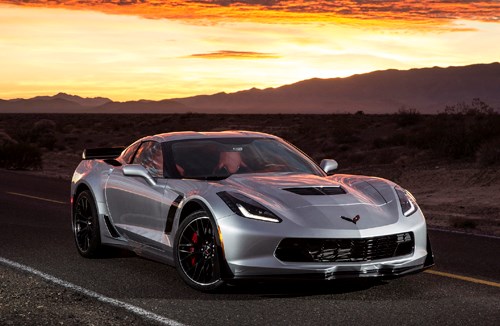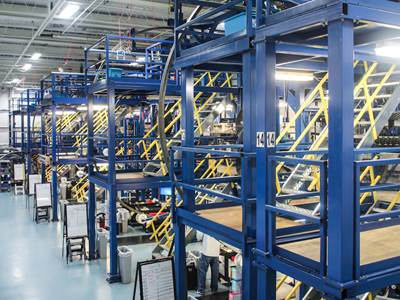For the Corvette, a smooth ride depends on composites
On a vehicle already famous for having a long history of composites use, finding a new part on which to apply the material is a challenge, but PolyOne’s Advanced Composites Glasforms unit managed to do just that.

Underbody braces for the Corvette C7, made via pultrusion and overwrapped carbon fiber fabric.
On a vehicle already famous for having a long history of composites use, finding a new part on which to apply the material is a challenge, but PolyOne’s Advanced Composites Glasforms unit managed to do just that with the underbody braces designed for the C7 generation Corvette, manufactured by General Motors (GM).
Ben Hochman, director of marketing at Glasforms, says he and his team had been meeting with GM engineers and discussing material and technical challenges on the Corvette. The topic of underbody braces came up. GM wanted to get away from the steel braces traditionally used and had developed an aluminum alternative that, unfortunately, was somewhat lacking in flexural stiffness. The result, says Hochman, was a less-than-optimal driving experience.
GM then turned to composites, but the challenge was developing the mechanical properties in all directions that the company required. And that’s where Glasforms stepped in.
There are four underbody braces on the Corvette — one associated with each wheel. Each brace is about 2 ft long, 1.25 inches wide, 0.375 inch thick, and notched at each end to accommodate metallic fasteners. The braces are designed to reduce chassis sway and confer greater stability in vehicle handling, giving a tighter “feel” to the driving experience. Basically, as underbody brace stiffness increases, so does handling stiffness. The “feel” of the Corvette has been highly developed by GM, and is expected by drivers. A composite underbody brace must, therefore, allow the Corvette to continue to meet that expectation.

Underside of Corvette. The braces are the black, narrow, diagonally oriented rods running from the outside edge of the vehicle toward the yellow wheel suspension system.
Hochman says Glasforms settled on an underbody brace design that would use a carbon fiber/epoxy composite manufactured via pultrusion. Pultrusion offers a constant cross-section, high stiffness and good longitudinal fiber alignment. What a pultruded part lacks, however, is good transverse strength. To manage that, says Hochman, “We developed three design scenarios for the brace, mixing and matching torsion and flexural stiffness.”
- A unidirectional, hybrid carbon and glass fiber profile
- A unidirectional carbon fiber profile
- A profile made with a unidirectional carbon fiber and a transverse engineered fabric, which had the advantage of minimizing potential cracks from propagating.
Testing at Wichita State University showed that the first option was an estimated 33% lighter than the aluminum part, with a 36% increase in flexural stiffness. The second option was estimated to be 41% lighter than the aluminum part, with a 100% increase in flexural stiffness, but a large reduction in torsional rigidity. The third profile was also 41% lighter than aluminum, with a 50% increase in flexural stiffness, and maintained torsional rigidity slightly better than that of aluminum.
GM engineers chose this third option because it met all of the technical requirements and had the best combination of properties.
The resulting brace assemblies, ultimately 17% lighter than their aluminum competitors, were delivered to GM for vehicle shake and road testing. They were validated and now are an upgrade option on the C7 Corvette.

Glasforms does all carbon fiber underbody brace manufacturing and has, says Hochman, “seen an increase in interest since the product’s release. The discerning buyer is very intrigued by the performance properties of these braces.”
Looking ahead, Hochman believes the braces have application on other vehicle platforms. He thinks Glasforms’ knowledge on composite design and manufacture will allow the company to adapt easily to other structural applications in automotive composites.
Related Content
Plant tour: Joby Aviation, Marina, Calif., U.S.
As the advanced air mobility market begins to take shape, market leader Joby Aviation works to industrialize composites manufacturing for its first-generation, composites-intensive, all-electric air taxi.
Read MoreCryo-compressed hydrogen, the best solution for storage and refueling stations?
Cryomotive’s CRYOGAS solution claims the highest storage density, lowest refueling cost and widest operating range without H2 losses while using one-fifth the carbon fiber required in compressed gas tanks.
Read MoreThermoset-thermoplastic joining, natural fibers enable sustainability-focused brake cover
Award-winning motorcycle brake disc cover showcases potential for KTM Technologies’ Conexus joining technology and flax fiber composites.
Read MoreASCEND program update: Designing next-gen, high-rate auto and aerospace composites
GKN Aerospace, McLaren Automotive and U.K.-based partners share goals and progress aiming at high-rate, Industry 4.0-enabled, sustainable materials and processes.
Read MoreRead Next
CFRP planing head: 50% less mass, 1.5 times faster rotation
Novel, modular design minimizes weight for high-precision cutting tools with faster production speeds.
Read MorePlant tour: A&P, Cincinnati, OH
A&P has made a name for itself as a braider, but the depth and breadth of its technical aptitude comes into sharp focus with a peek behind usually closed doors.
Read MoreModeling and characterization of crushable composite structures
How the predictive tool “CZone” is applied to simulate the axial crushing response of composites, providing valuable insights into their use for motorsport applications.
Read More






















